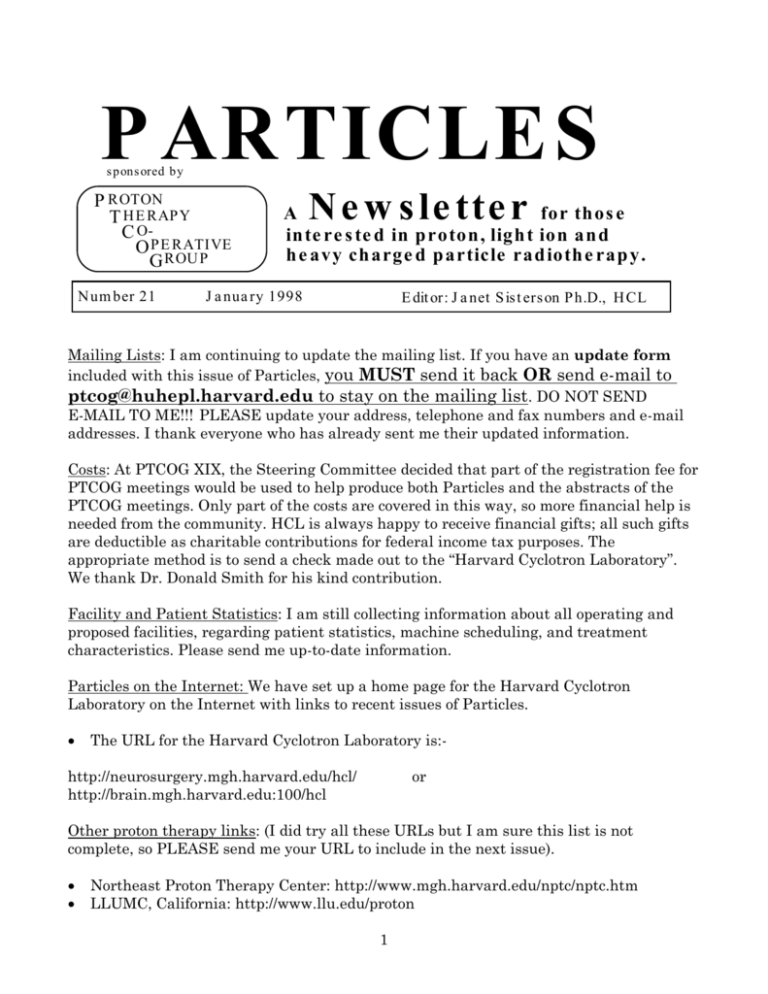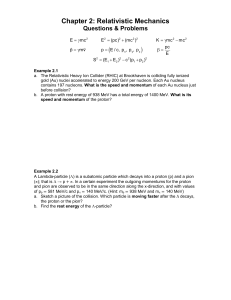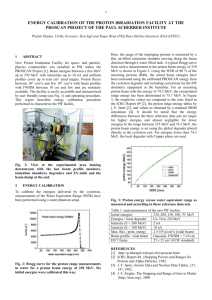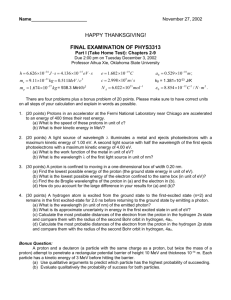ptles21
advertisement

P ARTICLES s pons ored by P ROTON T H E RAP Y C OO P E RATIVE G ROU P N um ber 21 N e w s le tte r A for th os e in te re s te d in p roton , ligh t ion an d h e avy ch arge d p article rad ioth e rap y. J a nua ry 1998 E dit or: J a net S is t ers on P h.D., H CL Mailing Lists: I am continuing to update the mailing list. If you have an update form included with this issue of Particles, you MUST send it back OR send e-mail to ptcog@huhepl.harvard.edu to stay on the mailing list. DO NOT SEND E-MAIL TO ME!!! PLEASE update your address, telephone and fax numbers and e-mail addresses. I thank everyone who has already sent me their updated information. Costs: At PTCOG XIX, the Steering Committee decided that part of the registration fee for PTCOG meetings would be used to help produce both Particles and the abstracts of the PTCOG meetings. Only part of the costs are covered in this way, so more financial help is needed from the community. HCL is always happy to receive financial gifts; all such gifts are deductible as charitable contributions for federal income tax purposes. The appropriate method is to send a check made out to the “Harvard Cyclotron Laboratory”. We thank Dr. Donald Smith for his kind contribution. Facility and Patient Statistics: I am still collecting information about all operating and proposed facilities, regarding patient statistics, machine scheduling, and treatment characteristics. Please send me up-to-date information. Particles on the Internet: We have set up a home page for the Harvard Cyclotron Laboratory on the Internet with links to recent issues of Particles. The URL for the Harvard Cyclotron Laboratory is:- http://neurosurgery.mgh.harvard.edu/hcl/ http://brain.mgh.harvard.edu:100/hcl or Other proton therapy links: (I did try all these URLs but I am sure this list is not complete, so PLEASE send me your URL to include in the next issue). Northeast Proton Therapy Center: http://www.mgh.harvard.edu/nptc/nptc.htm LLUMC, California: http://www.llu.edu/proton 1 U of California, Davis: http://crocker.ucdavis.edu/cnl/research/eyet.htm Indiana University: http://nike.iucf.indiana.edu/ptherapy/ TRIUMF, Canada protons: http://www.triumf.ca/welcome/proton_thrpy.html TRIUMF, Canada pions: http://www.triumf.ca/welcome/pion_trtmt.html NAC, South Africa: http://www.nac.ac.za/~medrad/index.html KVI, The Netherlands: http://www.kvi.nl/disk$1/protonlib/www/homepage.html PSI, Switzerland: http://www1.psi.ch/www_asm_hn/asm_home_page.html Proton Oncological Therapy, Project of the ISS, Italy: http://top.iss.infn.it TERA foundation, Italy: http://www.tera.novara.it Tsukuba, Japan: http://www-medical.kek.jp/index.html Tsukuba, Japan - new facility plans: http://www-medical.kek.jp/devnewfac.html HIMAC, Chiba, Japan: http://www.nirs.go.jp/ENG/particl.htm ARTICLES FOR PARTICLES 22 The deadline for news for Particles 22, the July 1998 issue, is May 30 1998. I will send reminders by fax or e-mail. Address all correspondence for the newsletter to: Janet Sisterson Ph.D. Harvard Cyclotron Laboratory 44 Oxford Street Cambridge MA 02138 Telephone: (617) 495-2885 Fax: (617) 495–8054 E-mail: sisterson@huhepl.harvard.edu Articles for the newsletter can be short but should NOT exceed two pages in length. The best way to send an article is by computer. If you mail or fax an article, remember that I scan them into the computer so I need a good clean copy of any figures. PTCOG and FUTURE PTCOG MEETINGS Chair: Michael Goitein Department of Radiation Oncology Massachusetts General Hospital Boston MA 02114 Steering Committee Members USA Europe J. Castro U. Amaldi Secretary: Janet Sisterson Harvard Cyclotron Laboratory 44 Oxford Street Cambridge MA 02138 Russia V. Khoroshkov 2 Japan K. Kawachi South Africa D. Jones W. Chu M. Goitein D. Miller J. Sisterson James Slater A. Smith L. Verhey H. Blattmann J.-L. Habrand G. Munkel E. Pedroni A. Wambersie H. Tsujii The times and locations of the next PTCOG meetings are as follows:PTCOG XXVIII Loma Linda, CA USA April 15 - 17 1998 PTCOG XXIX Heidelberg, Germany *** NEW DATES*** September 14 - 16 1998 PTCOG XXX NAC, Cape Town, South Africa April 12 - 15 1999 Note added March 1998: Note the NEW revised dates for PTCOG XXX in Heidelberg. 1997 NIRS International Seminar on Heavy Charged Particle Therapy in conjunction with PTCOG XXVII Chiba, Japan, November 17 - 19 1997 This was a very interesting and well attended meeting and an excellent opportunity to hear the Japanese experience and advances in proton and carbon ion therapy. All the attendees enjoyed the hospitality provided by our hosts. 187 people attended the meeting; 130 from Japan; 21 from the USA; 12 from Taiwan; 6 from Russia; 5 from Belgium; 4 from Germany; 3 from Austria; 2 each from Switzerland and South Africa and 1 each from Italy and the People’s Republic of China. Contributed papers (after a due referee process) will be published as a special issue of the journal of the Japanese Society of Therapeutic Radiology and Oncology. 1998 PTCOG XXVIII Rancho Mirage, California 3 April 15 – 17, 1998 Hosted by Loma Linda University Medical Center The meeting of PTCOG XXVIII will be held on Wednesday April 15 through Friday April 17, 1998 at the Marriott’s Rancho Las Palmas Resort in Rancho Mirage, California in the Palm Springs area. The meeting is sponsored by Loma Linda University Medical Center. Registration: Deadline for registration is March 6, 1998. Please return the enclosed registration form as soon as possible with your presentation plan. Registration Fees: $240.00; this includes a reception on Tuesday evening, transportation to and from LLUMC, lunch, and an evening social hour at LLUMC on Wednesday, and the conference dinner on Thursday. Accommodation: Marriott’s Rancho Las Palmas Resort is offering a special rate for the meeting, effective from Tuesday, April 14 – Friday, April 17. The room rate will be $162.00 for single/double occupancy per room, per night plus tax. Deadline to reserve a room at the special rate is March 17, 1998. A hotel registration form is included in this mailing. Optional Accommodations: Days Inn Suites 69151 E. Palm Canyon Drive Cathedral City, CA (760) 324-5939 Studio w/queen or 2 doubles $95.00 + tax per night Approx. 4 miles east of meeting site Holiday Inn Express 74675 Highway 111 Palm Desert, CA (760) 340-4303 $109.00 + tax per night (includes continental breakfast) Approx. 15 minutes east of meeting site Travelers Inn 72332 Highway 111 Palm Desert, CA (760) 341-9100 $90.00 - tax per night Approx. 1/2 mile east of meeting site The Marriott’s Rancho Las Palmas Resort is located in the Palm Springs area. From fall through late spring, days are warm and nights are cool. The average daily minimum – maximum temperature for the month of April is 57 – 94 degrees. Rancho Mirage is approximately 15 miles east of Palm Springs, which is the nearest airport. The next closest airport is the Ontario International Airport which is approximately 75 miles west of Rancho Mirage and then LAX Airport which is approximately 130 miles west of Rancho Mirage. 4 Transportation: Hertz has been selected as our official car supplier. When calling to reserve cars please use our identification # 24577. The numbers to use are, if you are calling from within the U. S., (800) 654-2240, from within Canada, (800) 263-0600, or from within Toronto (416) 620-9620. Contact Person: Gwen Houston 11234 Anderson St., B121 Loma Linda, CA 92354 PHONE: (909) 824-4257 FAX: (909) 824-4083 Abstracts: Contributors are invited and strongly encouraged to submit an abstract of their presentation that will be published in the July 1998 issue of Particles. The abstract should be about one half page in length, include authors and affiliations. Abstracts will be collected at the meeting or may be sent to Janet Sisterson by one of the means listed earlier in this newsletter. THE BEST METHOD is by e-mail to Sisterson@huhepl.harvard.edu. Tentative Schedule Day Tuesday, April 14 Time 6:00 p.m. Site Marriott Events Registration and Social Hour Wednesday, April 15 8:00 am 10:00 – 12:00 10:00 – 12:00 1:00 – 4:30 5:00 – 6:30 7:00 – 8:30 9:00 LLUMC LLUMC LLUMC LLUMC LLUMC LLUMC LLUMC Bus transport to LLUMC Physics Session Protocol Working Group Operations and Integration Tour of Proton Area Social Hour Bus transport to Marriott Thursday, April 16 8:30 – 10:00 10:15 – 12:00 1:00 – 2:30 2:45 – 5:00 6:30 Marriott Marriott Marriott Marriott Marriott Physics Session Radiation Biology Session Clinical Session Clinical Session Conference Dinner Friday, April 17 8:30 – 9:00 9:00 – 10:00 10:15 – 12:00 Marriott Marriott Marriott Business Meeting Physics/Biology Session Clinical Session/Protocol Group Report 5 12:30 – 2:30 Marriott Mixed – Focus Session Emphasis: The Operations and Integration session will emphasize efficiency and quality improvement measures that assist the operation of a high-volume proton therapy facility. Clinical sessions will focus on treatment protocols and clinical results. Suggestions for physics emphasis include Variable Energy Beam Delivery, Acceptance Testing, Commissioning and QA Procedures, Intensity Optimization, Uncertainties in Treatment Planning and Dose Delivery, and Biological Response Modeling. PTCOG Information/News/Reports: The following reports were received by January 1998. Heavy-ion therapy at GSI, Darmstadt, Germany: First patients treated. Two days after having received the legal approval, patient treatment started at Darmstadt, on Saturday December 13 1997. Two patients suffering from tumours at the base of skull were treated with five and four fractions of carbon ions respectively, within the course of their high precision radiotherapy at the German Cancer Research Centre in co-operation with the radiological clinic of the University, both at Heidelberg. In each fraction, two target doses 0.4 Gy were applied in opposite fields using the novel raster scan technique. Up to 60 energy slices, sometimes extending over many hundreds of pixels had to be used to cover the extended tumour volume. Set-up time for one field was approximately half an hour, treatment time about 12 minutes. Beam position and intensity were monitored on-line and compared to the precalculated values. A 3-dimensional reprojection of the position of the stopping radioactive carbon isotopes was provided by an on-line PET system developed by the group of FZ Rossendorf, a few minutes after irradiation. A full reconstruction was available after one hour. In both cases, on-line position monitoring and PET reconstruction showed no discrepancies within the accuracy of both methods. Patient treatment will restart in the second half of 1998 after the installation of a new physics Cave, that was postponed in order to start the therapy program first. Gerhard Kraft, GSI Darmstadt. Planckstrasse 1, D-64291 Darmstadt, Germany. Status of the Northeast Proton Therapy Center, Boston Construction: The Northeast Proton Therapy Center is on the main campus of Massachusetts General Hospital. The center will be used to conduct cancer therapy research and to provide treatments which have been proven to be effective. It is designed with a capacity to treat up to 1000 patients, delivering 10,000 treatment fractions, per year. The NPTC will contain three treatment rooms, two with isocentric rotating Gantries and one with 6 horizontal beam lines that can be used for eye treatments, and for large field beams for research and dosimetric studies. Proton beams in the energy range 70 to 235 MeV will be provided with rapid (2 sec) energy switching. The Gantries will be capable of delivering beams for different beam spreading methods including passive scattering, wobbling and scanning. A robotic patient positioner is designed to provide patient positioning to submillimeter accuracy. The NPTC construction is being jointly funded by the National Cancer Institute and the MGH. The building was completed in March, 1997. It is shown in the photo below. The photograph of the building is not included in the Web version of Particles. The cyclotron, which was installed in June of 1997, has been operated frequently while studying the beam parameters and has proven to be reliable. The installation of the first Gantry began in October, 1997. The Gantry structure allows the isocenter to point within ±0.5mm of the intended location. Factory construction of the Patient Positioner is almost complete. Preliminary testing gives reproducibility results on the order of ±0.2 mm or less. Although effects such as elastic deflection result in some additional inaccuracy, studies using the actual data show that most of the inaccuracy of the PPS is due to deflection and can be corrected very close to the level of the reproducibility. Over the next few months the remainder of the equipment will be installed. After the second Gantry is installed, the finishing touches will be put on the building. The projected schedule continues to foresee treating our first patient in the Fall of 1998 using the first Gantry. J. Flanz, S. Bradley, S. Durlacher, M. Goitein, J. Loeffler, A. Smith, and S. Woods, Massachusetts General Hospital, 30 Fruit Street, Boston MA 02114 Update from Indiana University, Indiana, USA: Construction of the eye treatment line has been completed. The initial treatments will be a clinical trial on choroidal neovascular membrane in age-related macular degeneration. Those treatments should begin in March. Plans have begun for a second treatment room. This will be a large-field horizontal beam line. The beam will be spread magnetically rather than using scattering foils. This will give a maximum range in water of 28 cm for the 210 MeV beam. Present plans call for this room to be operational in the beginning of 1999. Indiana University has started screening applicants for the medical director position, and hopes to have this person on board this summer. Chuck Bloch, Indiana University Cyclotron Facility, 2401 Milo B. Sampson Lane, Bloomington, IN 47408-0768. News from TANDAR, Buenos Aires, Argentina: A cooperative program has started between the Physics Department of the Atomic Energy Commission of Argentina and the School of Science and Technology of the National University of San MartÃn on one hand and the Centre de Protontherapy 7 dÌOrsay, France on the other, to promote exchange of scientists and students and common research in physics and radiobiology with proton beams at the Tandem accelerator (TANDAR) in Buenos Aires and at the Synchrocyclotron in Orsay. This activity will also be the starting point for a feasibility study to eventually introduce protontherapy in Argentina. Drs. A. Mazal, J.-C. Rosenwald and A. Touati gave a two weeks seminar on the physical and biological basis of radiotherapy and specifically protontherapy to physicians, physicists, radiobiologists and students interested in this project. This seminar was also supported by the French Embassy in the frame of the celebration of the centennial of the discovery of radioactivity. A first external proton beam of 20 MeV has been produced and used for dosimetric measurements and irradiation of mice as a first step to start a radiobiology research activity. Andr»s J. Kreiner, Departamento de Fmsica, TANDAR, CNEA, Avda. Libertador 8250, 1429 Buenos Aires, Argentina and Alejandro Mazal, Centre de Protontherapie d’Orsay, BP 65, Orsay cedex 91420, France. The Hadrontherapy Programme of the TERA Foundation As far as the direct intervention of the TERA Foundation is concerned, the design and construction activities of the Hadrontherapy Programme are organised in four projects. The work done by the members of the Hadrontherapy Collaboration in these areas and in hadron radiobiology and dosimetry, with the continuous support of the National Institute of Nuclear and Subnuclear Physics (INFN), has been published in the Blue Book [1], the Green Book [2] and the Red Book [3]. 1. The CNAO Project From the beginning of 1992, the TERA Foundation is engaged in the design and realisation of the hadrontherapy centre CNAO based on a synchrotron which can accelerate protons to at least 250 MeV and carbon ions to at least 4500 MeV (i.e. 4500/12 = 375 MeV/u). This will be a centre of excellence devoted to tumour hadrontherapy of more than one thousand patients/year, to clinical research in cancer therapy and to R&D in the fields of radiobiology and dosimetry. Dr. Giorgio Brianti, past CERN Technical Director, is the Chairman of the CNAO Project Advisory Committee. Five TERA staff members and two doctoral students from the AUSTRON Project (Vienna) participate in the study called PIMMS (PIMMS = Protons and Ions Medical Machine Study), started in 1996 at CERN, which aims at finding new optimised solutions for the synchrotron and the isocentric proton gantries. In spring 1996 Prof. Hans Specht, Director General of GSI (Darmstadt), decided that GSI will contribute by taking the responsibility for the design of the ion injector and of a gantry for carbon ions. This common activity of CERN, TERA, AUSTRON and GSI aims at a first document to be ready by summer 1998. For a medical synchrotron the intensity of the extracted beams poses no special problem, since 1011 p/s and 3 109 ions/s are enough. The issue is the time uniformity of the spill since, due mainly to the magnet ripples, synchrotron pulses have time structures at many frequencies; this makes the active spreading of the beams difficult. The main features of the synchrotron design can be summarised as follows: 8 * during the extraction all optics functions are kept rigorously constant (stable orbits and beam sizes); * a betatron core is used to accelerate the beam into the resonance. This element has the only power converter that changes during extraction (machine is very 'quiet'); * the betatron core will have smoothing applied to the DAC steps; * the main converters will be combinations of a booster for ramping and a lower voltage converter (switch-mode if possible) for holding the flat-top; * the beam entering the resonance has a range of momenta and betatron amplitudes that tend to compensate medium frequency ripple; * a channelling bucket will be used to speed up the entry of the particles into the resonance in order to dampen the response to low-frequency ripple. While initiating this European collaboration, in December 1995 the TERA Foundation offered to nine hospitals, oncological institutes of Milano and Pavia and universities to form a consortium and realise the CNAO in Milano. The instrument of understanding was signed by: Salvatore Maugeri Foundation (Pavia), TERA Foundation (Novara), European Institute of Oncology (Milan), National Institute for Tumour Research and Cure (Milan), National Neurological Institute Besta (Milan), Ospedale Maggiore Polyclinic (Milan), San Matteo Polyclinic (Pavia), Polytechnical School (Milano), University of Milano, University of Pavia. The Polyclinic of Milano put at the disposal of CNAO a wonderful site located close to the Mirasole Abbey, South of Milano on the road going to Pavia1. The National Oncological Commission gave its positive opinion on the CNAO project in December 1995. 2. The "compact" accelerators Project PACO In the framework of the Hadrontherapy Programme, in the years 1993-1995 four working groups have designed four novel medical proton accelerators: two synchrotrons, a superconducting cyclotron and a high-frequency (3 GHz) proton linac. They are described in the Green Book. Since 1993 the Istituto Superiore di Sanitá (ISS) in Rome decided to request special funds for the construction of a prototype of a "compact" accelerator (and its rotating gantry) and to finance R&D programmes in the fields of radiobiology, dosimetry, networking, pathology and treatment planning. In September 1995 the decision was to construct the first part of the high-frequency proton linac, whose injector will also be capable of producing PET isotopes. In 1997 an agreement is going to be signed between ISS, Institute Regina Elena (IRE), ENEA (Ente Nazionale per le nuove tecnologie, lÌEnergia e lÌAmbiente) and TERA for the construction of the accelerator on a convenient site located in between the buildings of ISS and of IRE. This programme is now known as the TOP Project of ISS, where TOP stands for "Terapia Oncologica con Protoni". 3. The RITA network The creation of an informatics and organisational network, called RITA (Italian Network for Hadrontherapy Treatment), which will connect the Associated Centres Ò distributed throughout Italy (and abroad) and situated in the public oncological institutions and in private clinics Ò with the Centres where proton and ion beams will be made available. The specialised medical and physics staff in these Associated Centres will be able to discuss in remote, through multimedia connections, the clinical cases with the 1 In March 1997, the bylaws of the Fondazione Medico Scientifica Mirasole, a non-for-profit Foundation which will be responsible for the construction and the management of CNAO, have been approved. At the beginning of June 1997 Ospedale Maggiore asked officially funds for building the first lot of CNAO to the Government of the Lombardy Region. 9 experts of the Hadrontherapy Centre and those of the Protontherapy Centres by using the most modern informatics means. They will exchange diagnostics images and some of the physicians at these Associated Centres (sometimes after using conventional radiotherapies) will even be in such a position as to plan a successive treatment for their patients, which will then be irradiated in one of the Centres where hadron beams are available. The implementation of the RITA network is already well advanced, so that a first connection between two oncological centres has been tested and a multimedia clinical folder for radiotherapy has been released. 4. A 3 Ghz Linac Booster (LIBO) for Proton Cyclotrons The design of a SCL linac used as a booster (from which the acronym LIBO = Linac Booster) of a 60-70 MeV proton cyclotron has been launched, in 1997, by the TERA Foundation. The development of this accelerator is very interesting because there are at least twenty 50-70 MeV cyclotrons in the world which could be transformed in facilities for protontherapy of deep tumours. In the Green Book the study was carried out with reference to the 62 MeV cyclotron of the Cyclotron Unit, Clatterbridge Hospital (UK). In a total length of 13 m, 9 modules formed of 4 tanks and powered by 9 klystrons take the proton beam from 62 to 200 MeV. The repetition rate is 400 Hz, which is good for a voxel active spreading of the beam. The overall linac capture efficiency, taking into account the fact that the linac acceptance is about three times the cyclotron emittance, is 1.5 10-4, so that the average proton current at 200 MeV is 10 nA. The power is about 100 kW. By switching off klystrons it is possible to vary the proton energy between 140 and 200 MeV. References: [1] The TERA Project and the Centre for Oncological Hadrontherapy, Vol.I and Vol.II, U.Amaldi and M Silari Eds, INFN, Frascati, 1995. Addendum, D. Campi and M. Silari Eds. The whole collection is called the "Blue Book". [2] The RITA Network and the Design of Compact Accelerators, U. Amaldi, M. Grandolfo and L. Picardi Eds, INFN, Frascati, 1996. The "Green Book". [3] The National Centre for Oncological Hadrontherapy at Mirasole, U. Amaldi Ed., INFN, Frascati, 1997. The "Red Book". U. Amaldi and Sandro Rossi, CERN, Geneva and TERA Foundation, Novara Proposed NEW FACILITIES for PROTON & ION BEAM THERAPY January 1998 INSTITUTION PLACE TYPE Berlin Germany p 1ST RX? 1998 10 COMMENTS 72 MeV cyclotron; eye treatment beam line. NPTC (Harvard) Kashiwa INFN-LNS, Catania Bratislavia CGMH, Northern Taiwan Hyogo NAC, Faure Tsukuba Wakasa Bay Shizuoka Cancer Center CNAO, Milan & Pavia AUSTRON Beijing Central Italy Clatterbridge TOP project ISS Rome 3 projects in Moscow HIRFL,Lanzhou Jülich (KFA) Krakow KVI Groningen Moscow Proton Development N.A. Inc. PROTOX MA USA Japan Italy Slovakia Taiwan Japan South Africa Japan Japan Japan Italy Austria China Italy England Italy Russia PR China Germany Poland The Netherlands Russia IL USA England p p p p, ion p p, ion p p p, ion p, ion p p p p p C ion p p p 1998 1998 1999 2000 2000 2001 2001 2001 2001? 2002? 2002? ? ? ? ? ? ? ? ? ? ? at MGH; 235 MeV cyclotron; 2 gantries + 3 horiz. 235MeV cyclotron;2gantries;1horiz; under construction 70 MeV; 1 room, fixed horiz. beam 75 MeV cyclotron; p; ions; +BNCT, isot prod. 250 MeV synchrotron, 3 gantries, I fixed beam 2 gantries; 2 horiz; 1 vert; 1 45 deg;under construction new treatment room with beam line 30o off vertical. 270 MeV; 2 treat rooms with gantries; 1 research room multipurpose accelerator; building completed mid 1998 synchrotron 230? MeV; 2 gantries; 1 horiz; funded. synchrotron; 1 gantry;2 fixed beam rooms;1 exp. room 1p gantry;1 ion gantry;2 fixed p,1 fixed ion,1 exp room 250 MeV synchrotron. cyclotron; 1 gantry; 1 fixed upgrade using booster linear accelerator. 200 MeV linac;1eye room; gantry?;under construction p p p ? ? 2001? 320 MeV; compact, probably no gantry 300 MeV protons; therapy & lithography existing RAL synchrotron; 250 MeV; 3 treat. gantry 11 exp. beam line; plans for therapy. 60 MeV proton beam. plan:- 200 MeV accel.; 2 rms; 1 gantry; 1 fix. WORLD WIDE CHARGED PARTICLE PATIENT TOTALS January 1998 WHO WHERE WHAT DATE DATE FIRST LAST RX RX Berkeley 184 Berkeley Uppsala Harvard Dubna Moscow Los Alamos St. Petersburg Berkeley Chiba TRIUMF PSI (SIN) PMRC, Tsukuba PSI (72 MeV) Dubna Uppsala Clatterbridge Loma Linda Louvain-la-Neuve Nice Orsay N.A.C. IUCF UCSF - CNL HIMAC, Chiba TRIUMF PSI (200 MeV) G.S.I Darmstadt CA. USA CA. USA Sweden MA. USA Russia Russia NM. USA Russia CA. USA Japan Canada Switzerland Japan Switzerland Russia Sweden England CA. USA Belgium France France South Africa IN USA CA USA Japan Canada Switzerland Germany p He p p p p πp heavy ion p ππp p p p p p p p p p p p heavy ion p p heavy ion 1954 1957 1957 1961 1967 1969 1974 1975 1975 1979 1979 1980 1983 1984 1987 1989 1989 1990 1991 1991 1991 1993 1993 1994 1994 1995 1996 1997 RECENT PATIENT TOTAL — 1957 — 1992 — 1976 30 2054 73 7432 84 2838 230 1028 433 96 367 503 547 2482 40 112 764 3001 21 1010 956 243 1 144 301 37 9 2 — 1974 — 1982 — 1992 — 1994 — 1993 TOTAL GGGGGGGGGGGGGGGGGGGGGGGG G 1100 2790 20948 24838 GG G 12 DATE OF TOTAL June-91 Jan-98 May-96 Dec-97 June-91 Oct-96 Dec-93 July-97 Dec-97 Dec-97 Apr-97 July-97 Dec-97 Nov-93 Jan-98 May-97 Dec-97 Dec-97 Dec-97 Aug-97 Jan-98 Dec-97 Dec-97 pions ions protons all particles G G G G See Page 10. G for G The Proposed New Facilities Table GGGGGGGGGGGGGGGGGGGGGGGG 13 G GG G








